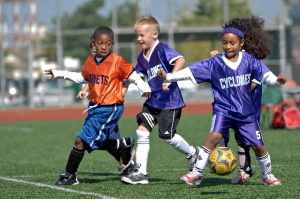9 Play
Learning Objectives
- Define play.
- Describe the six types of play that emerge over time.
- Define pretend play and describe how it contributes to development.
- Describe the ways that children benefit from play.
- Explain how we can promote healthy play.
The Role of Play in Development

What is Play?
Play is spontaneous fun activity found at all ages and in all cultures. Play begins in infancy. Freud analyzed play in terms of emotional development. Vygotsky and Piaget saw play as a way for children to develop their intellectual abilities (Dyer & Moneta, 2006). Piaget called play “a child’s work.” Subsequent research has shown that play provides many positive outcomes for children in all domains of development. The activity of play provides children opportunities to exercise all their developing capacities: physical, cognitive, emotional, and social. Play is spontaneous; children are intrinsically motivated to play. Play may be done alone or with others. It often involves pretending and make-believe.
Types of Play
In a classic study, Parten (1932) observed two to five-year-old children and noted six types of play: Three labeled as non-social play (unoccupied, solitary, and onlooker) and three categorized as social play (parallel, associative, and cooperative). The following Table describes each type of play. Younger children engage in non-social play more than older children; by age five associative and cooperative play are the most common forms of play (Dyer & Moneta, 2006).
Table 9.1 Parten’s Classification of Types of Play in Preschool Children
| Category | Description |
|---|---|
| Unoccupied Play | Children's behavior seems more random and without a specific goal. This is the least common form of play. |
| Solitary Play | Children play by themselves, do not interact with others, nor are they engaging in similar activities as the children around them. |
| Onlooker Play | Children are observing other children playing. They may comment on the activities and even make suggestions, but will not directly join the play. |
| Parallel Play | Children play alongside each other, using similar toys, but do not directly act with each other. |
| Associative Play | Children will interact with each other and share toys, but are not working toward a common goal. |
| Cooperative Play | Children are interacting to achieve a common goal. Children may take on different tasks to reach that goal. |
adapted from Paris et al., 2019
Pretend Play
Pretense is a familiar characteristic of play. Pretend play can be combined with physical play or playing with objects. When pretending, children act as-if; they engage in make-believe. Their words and actions are not literal, but evoke something beyond what is concretely present (Lillard et al., 2015). In his study of cognitive development, Piaget was interested in pretend play and he documented the way in which it involved symbolic thought, that is, the ability to have a symbol represent something in the real world. A toy, for example, has qualities beyond the way it was designed to function, and can be used to stand for a character or a completely different object. A banana can be used as a telephone. As seen in the study of early childhood, symbolic thought is an important capability developed at the end of the sensorimotor stage that paves the way for the development of language. But pretend play uses capabilities that go beyond symbolic thought and mental representation.

Pretend play also requires the use of fantasy and imagination (Sobel & Lillard, 2001). Imagination is distinct from, but jointly engaged during play with executive function, including the developing capabilities of memory, inhibition, and attention shifting (Carlson & White, 2013). A complex form of pretend play emerges in Parten’s last two stages, associative play, and cooperative play. This new form is sociodramatic play, which is make-believe play with others, involving objects and actions woven into some kind of imagined situation or story. It is often scaffolded in play with adults or older children. As the development of sociodramatic play progresses, children begin acting out roles. They use situated imaginary identities as the basis of action and to create story lines. Through the creation of settings, roles, and narrative, imagination is used to explore ideas about what follows what, and about how things unfold in the world (Deunk et al., 2008). Perspective taking is improved through this social form of pretend play. Emotional development also is also fostered by sociodramatic play, as children choose imagined interpretations and responses to imagined emotions in pretend situations, and responds to emotions that arise in actual conflict generated between playmates. Perspective taking and dealing with emotions during pretend play contribute to the development of self-regulation (Gioia & Tobin, 2020).
Link to Learning: Benefits of Play
“Play in all its rich variety is one of the highest achievements of the human species,” says Dr. David Whitebread from Cambridge University’s Faculty of Education. “It underpins how we develop as intellectual, problem-solving, emotional adults and is crucial to our success as a highly adaptable species.” International bodies like the United Nations and the European Union have begun to develop policies concerned with children’s right to play, and to consider implications for leisure facilities and educational programs.
Thanks to the Centre for Research on Play in Education, Development and Learning (PEDaL) at Cambridge, Whitebread, Baker, Gibson and a team of researchers are accumulating evidence on the role played by play in how a child develops. “A strong possibility is that play supports the early development of children’s self-control,” explains Baker, “. . . our abilities to develop awareness of our own thinking processes.” If playful experiences do facilitate this aspect of development, say the researchers, it could be extremely significant for educational practices because the ability to self-regulate has been shown to be a key predictor of academic performance.
Gibson adds: “Playful behaviour is also an important indicator of healthy social and emotional development. In my previous research, I investigated how observing children at play can give us important clues about their well-being and can even be useful in the diagnosis of neurodevelopmental disorders like autism.”
Source: Plays the Thing, Cambridge University https://www.cam.ac.uk/research/features/plays-the-thing is licensed under a CC BY 4.0
Sports and Physical Education

Middle childhood seems to be a great time to introduce children to organized sports, and in fact, many parents do. Nearly 3 million children play soccer in the United States (United States Youth Soccer, 2012). This activity promises to help children improve athletically, learn a sense of competition, and build social skills. However, it has been suggested that the emphasis on competition and athletic skill can be counterproductive and lead children to grow tired of the game and want to quit. In many respects, it appears that children’s activities are no longer children’s activities once adults become involved and approach the games as adults rather than children. The U. S. Soccer Federation recently advised coaches to reduce the amount of drilling engaged in during practice and to allow children to play more freely and to choose their own positions. The hope is that this will build on their love of the game and foster their natural talents.
Sports are important for children. Children’s participation in sports has been linked to:
- Higher levels of satisfaction with family and overall quality of life in children
- Improved physical and emotional development
- Better academic performance
Yet, a study on children’s sports in the United States (Sabo & Veliz, 2008) has found that gender, poverty, location, ethnicity, and disability can limit opportunities to engage in sports. Girls were more likely to have never participated in any type of sport. They also found that fathers may not be providing their daughters as much support as they do their sons. While boys rated their fathers as their biggest mentors who taught them the most about sports, girls rated coaches and physical education teachers as their key mentors. Sabo and Veliz also found that children in suburban neighborhoods had a much higher participation of sports than boys and girls living in rural or urban centers. In addition, Caucasian girls and boys participated in organized sports at higher rates than minority children.
Students don’t always persist in their participation in extracurricular and other organized sports activities. Sabo and Veliz asked children who had dropped out of organized sports why they left. For both girls and boys, the number one answer was that it was no longer any fun (see Table 9.2). According to the Sport Policy and Research Collaborative (SPARC) (2013), almost 1 in 3 children drop out of organized sports, and while there are many factors involved in the decisions to drop out, one suggestion has been the lack of training that coaches of children’s sports receive may be contributing to this attrition (Barnett et al., 1992). Several studies have found that when coaches receive proper training, the drop-out rate is about 5% instead of the usual 30% (Fraser-Thomas et al., 2005; SPARC, 2013).
Table 9.2 Top Reasons Dropped Out or Stopped Playing Organized/Team Sports
| Girls | Boys | ||
|---|---|---|---|
| I was not having fun | 38% | I was not having fun | 39% |
| I wanted to focus more on studying and grades | 36% | I had a health problem or injury | 29% |
| I had a health problem or injury | 27% | I wanted to focus more on studying and grades | 26% |
| I wanted to focus more on other clubs or activities | 22% | I did not like or get along with the coach | 22% |
| I did not like or get along with the coach | 18% | I wanted to focus more on other clubs or activities | 18% |
| I did not like or get along with others on the team | 16% | I did not like or get along with others on the team | 16% |
| I was not a good enough player | 15% | I was not a good enough player | 15% |
| My family worried about me getting hurt or injured while playing sports | 14% | My family worried about me getting hurt or injured while playing sports | 12% |
Source: Sabo, D., & Veliz, P. (2008). Go Out and Play: Youth Sports in America. East Meadows, NY: Women’s Sports
Physical Education
For many children, physical education in school is a key component in introducing children to sports and regular physical activity. After years of schools cutting back on physical education programs, there has been a turnaround, prompted by concerns over childhood obesity and related health issues. Despite these changes, currently only the state of Oregon and the District of Columbia meet PE guidelines of a minimum of 150 minutes per week of physical activity in elementary school and 225 minutes in middle school (SPARC, 2016). There is also controversy about physical education. Some experts recommend changing the content of these classes. Training on competitive sports, often a high priority, is unlikely to reach the least physically fit youngsters. Instead, programs could emphasize cooperation, enjoyable informal games, and individual exercise.
References (Click to expand)
Barnett, N. P., Smoll, F. L., & Smith, R. E. (1992). Effects of enhancing coach-athlete relationships on youth sport attrition. The Sport Psychologist, 6, 111-127.
Carlson, S. M., & White, R. E. (2013). Executive function, pretend play, and imagination. In The Oxford handbook of the development of imagination (pp. 161–174). Oxford University Press.
Deunk, M., Berenst, J., & De Glopper, K. (2008). The development of early sociodramatic play. Discourse Studies, 10(5), 615–633.
Dyer, S., & Moneta, G. B. (2006). Frequency of parallel, associative, and cooperative play in British children of different socio-economic status. Social Behavior and Personality, 34(5), 587-592.
Fraser-Thomas, J. L., Côté, J., & Deakin, J. (2005). Youth sport programs: An avenue to foster positive youth development. Physical Education & Sport Pedagogy, 10, 19-40.
Gioia, K. A., & Tobin, R. M. (2010). Role of sociodramatic play in promoting self-regulation. In Play therapy for preschool children (pp. 181–198). American Psychological Association.
Lillard, A. S., Lerner, M. D., Hopkins, E. J., Dore, R. A., Smith, E. D., & Palmquist, C. M. (2013). The impact of pretend play on children’s development: A review of the evidence. Psychological Bulletin, 139(1), 1–34.
Parten, M. B. (1932). Social participation among preschool children. Journal of Abnormal and Social Psychology, 27, 243-269.
Sabo, D., & Veliz, P. (2008). Go out and play: Youth sports in America. East Meadow, NY: Women’s Sports Foundation .
Sobel, D. M., & Lillard, A. S. (2001). The impact of fantasy and action on young children’s understanding of pretence. British Journal of Developmental Psychology, 19(1), 85–98.
Sport Policy and Research Collaborative (SPARC, 2013). What is the status of youth coach training in the U.S.? University of Florida. Retrieved from https://assets.aspeninstitute.org/content/uploads/files/content/upload/Project%20Play%20Research%20Brief%20Coaching%20Education%20–%20FINAL.pdf
United States Youth Soccer. (2012). US youth soccer at a glance. Retrieved from http://www.usyouthsoccer.org/media_kit/ataglance/
Licenses & Attributions (Click to expand)
CC Licensed Content
- “Lifespan Development: A Psychological Perspective, Second Edition” by Martha Lally and Suzanne Valentine-French is licensed under a CC-BY-NC-SA-3.0
- Lifespan Development by Lumen Learning is licensed under a Creative Commons Attribution 4.0 International License
- Child Growth and Development by College of the Canyons, Jennifer Paris, Antoinette Ricardo, and Dawn Rymond and is used under a CC BY 4.0 international license
- Plays the Thing, Cambridge University is licensed under a CC BY 4.0
- “Play and Peers” by Dan Grimes & Brandy Brennan, Portland State University, and is licensed CC-BY-NC-SA-4.0
Media Attributions
- peter-idowu-xA0HEsQTcpc-unsplash © Peter Idowu is licensed under a CC0 (Creative Commons Zero) license
- soraya-irving-9UEu-pyGOJU-unsplash © Soraya Irving is licensed under a CC0 (Creative Commons Zero) license
- sports
